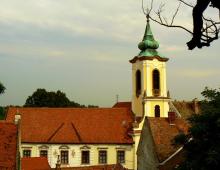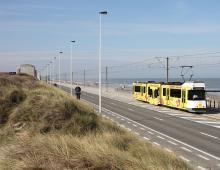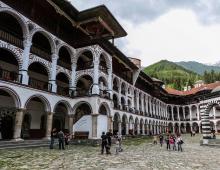Ossuary in Sedlec - Church of All Saints (Kutná Hora). Museum of Bones - Ossuary, Czech Republic, Sedlec Cathedral of Skulls Prague
Skulls lovingly arranged on shelves. Bones neatly stacked into huge pyramids. The ribs, collarbones and hip joints from which chandeliers and bowls are made. Forty thousand human skeletons turned into works of art. Scary? No, rather, it's interesting. Although it's probably creepy. The ossuary in Kutna Hora is one of the most unusual places I have been to. The Czech Republic never ceases to amaze and amaze. On the eve of Halloween, this photo report looks even more appropriate) Welcome, the master invites you to visit.
A small, seemingly unremarkable chapel in the middle of a cemetery on the outskirts of the city of Kutna Hora. The place is called Sedlec.  2.
2.
Formally, the Gothic chapel is called the Church of All Saints, but everyone knows it exclusively as an ossuary. 

A small panorama. In the corners of the chapel, behind bars, there are four pyramids of bones. A huge chandelier hangs from the middle of the nave. There are garlands of skulls around. This is a really strange place.  5.
5.
To begin with, according to tradition, the history of the place in two paragraphs. In 1278, a certain abbot Henry went to Jerusalem. He brought a handful of earth from Golgotha and scattered it over the cemetery. This land immediately began to be considered holy and every respectable person wanted to be buried in it. Rumors quickly spread throughout neighboring regions, and soon residents of almost all of Central Europe dreamed of resting in this cemetery. The plague and constant wars took their toll - there was not enough room for everyone. In 1400 they found a way out - a cathedral with a tomb was built in the cemetery. The bones from the old graves were moved there, and new dead people began to be buried in the ground.  6.
6.
 7.
7.
Such structures were par for the course in medieval Europe. When the cemetery ran out of space, the monks simply dug up the bones and threw them into the deep cellars of the chapels. In Sedlec, the ossuary was watched over by a half-blind monk, apparently with oddities. One day he stopped throwing bones into the basement - why waste them - and began laying out pyramids and all sorts of figures from them. According to the plan, all this was supposed to symbolize the resurrection. The brothers did not appreciate the creation and closed the creepy chapel. They remembered her only three hundred years later. Then the emperor closed the abbey and sold the monastery lands to the Schwarzenberg family - the largest landowners in Bohemia.  8.
8.
 9.
9.
The Count liked the idea. In 1870 he asked local woodcarver František Rint to create something Gothic. He put the pile of bones in order - bleached, sorted and created a work of art from them. He covered the walls and vaults with skulls, hung bones from the ceiling, and created a family coat of arms and a chandelier. It uses absolutely all human bones. 

The Schwarzenberg family coat of arms is another creation of Frantisek Rint.  12.
12.
At the bottom right of the coat of arms is a Turk whose eye is pecked out by a raven. Adolf von Schwarzenberg commanded a regiment of imperial troops in the war with the Turks and in 1599 was awarded the title of count for the liberation of the Hungarian fortress of Győr.  13.
13.
Signature of the master himself.  14.
14.
About 40 thousand human skeletons were used to decorate the chapel. A whole small city. By the way, half as many people live in Kutna Hora itself.  15.
15.
 16.
16.
The rich were buried whole. The interior was created from the remains of the poor and unknown wanderers. Siedlce Cemetery is a place where miracles are expected. Everyone buried here was sure that they would be resurrected. The logic is simple - the abbot brought the soil from the place where Jesus was crucified. Jesus put an end to death. To be near the holy land means to be closer to Jesus, and, accordingly, to salvation.  17.
17.
This is one of the few ossuaries preserved in Europe. The Vatican has long insisted on closing the ossuary, but UNESCO and common sense are winning so far.  18.
18.
 19.
19.
Everyone considers it their duty to throw a coin into the skull for good luck. Hit the eye socket - well done.  20.
20.
 21.
21.
Chilling beauty.  22.
22.
Happy upcoming Halloween) To be honest, I didn’t plan to post a post specifically for this day, it just coincided so well.  23.
23.
Literally opposite the chapel is the Cathedral of the Assumption of the Virgin Mary. It looks pompous, but no one goes there, everyone wants to go to the ossuary.  24.
24.
And, by the way, one of the oldest abbeys in the whole Czech Republic.  25.
25.
Liked? Click like and repost.
For those who missed my first photo report from the Czech Republic. Olomouc is a city founded by Caesar. In my opinion, this is the most underrated Czech city among our tourists. And completely in vain. There is something to see and where to walk.
One of the most amazing and extraordinary monuments of world architecture is the Ossuary in the Czech Republic. This structure was erected over several centuries in order to remind all of humanity how terrible and terrible death is. Of course, the frame of the building itself is made of more durable building materials, but the arches, portals, decorations, inscriptions, as well as the famous chandelier included the bones of more than 40 thousand people.
The ossuary in the Czech Republic is now located in a town located 70 kilometers from Prague. In ancient times, this village was built on a silver deposit, and therefore was a major economic and commercial center of the country. Later, these treasures were exhausted here, and the city itself was covered by a wave of plague. This was followed by armed uprisings and wars that finally destroyed the former financial center of the state, and Kutna Hora became just a small province. However, the same notorious Ossuary still glorifies it.

The 13th century was a terrible time. People died in large numbers, and as a result, cemeteries grew across uninhabited areas at tremendous speed. Soon, secondary burials began to be practiced in the country, and those bones that had already spent many years in the ground were taken out and placed in the local Sedlec monastery, which served as a chapel at the cemetery. By the 14th century, the bones of more than 40 thousand people had collected in this place, and one of the monks decided to bleach them. Gradually clearing out each bone, he stacked them into pyramids, which eventually turned out to be 6 pieces, each several meters long. After the death of this monk, the Sedlec Monastery was closed for 350 years.

The Ossuary itself in the Czech Republic was born in the 18th century, when a certain F. Rint carved a real work of art from all these human remains. Its technology still remains secret, but the wonders of this non-standard art form delight the eye and inspire philosophical reflection. It is also known that everyone who enters this church will remember the terrible beauty for the rest of their lives.
The ossuary in the Czech Republic includes absolutely all parts of the human skeleton. The oblong ones became the basis for the coat of arms and crown, skulls decorated the portals and arches. But the greatest delight is caused by the huge chandelier, in which the master placed bones of all kinds: both phalanges and twisted coccyxes. It is worth noting that this cathedral is very large, and despite this, each of its cells, each hall and passage is equipped with patterns and hand-cutting from this material. That is why the Ossuary in the Czech Republic is considered a temple, an example of the severity of Medieval architecture and the horror that a human skeleton can instill in the soul.
Photos of this work of art, as well as its most outstanding parts, are presented in the article, and before traveling to this country, you can appreciate the greatness and horror that lurk in this place. Finally, it is worth noting that, despite the huge number of human remains concentrated in one place, there are still no legends about possible ghosts and spirits living here.
This question can be asked by those who were simply told about the unusual church in Sedlec. Those who visited it were divided into several groups, each of which experienced their own emotions.
We’ll say one thing for sure: it’s better for impressionable people not to go inside, or after a visit to the Ossuary, go to some bright place that will block the memories of what they saw. Although, will you forget this?
The corners of the cathedral are decorated with piles of bell-shaped bones. In the center there are 4 obelisks decorated with skulls. A bone candelabra with garlands of skulls hangs from the middle of the nave. The altar monstrances did not escape the fate of being made from human bones. You will see them on both sides of the altar.
The chandelier's fastenings to the ceiling are also made of bones. An interesting fact is that the chandelier contains all the bones that are in the human body - at least one copy of each.

The coat of arms of the Schwarzenberg family is present here - large and made of bones. See photo on the right, click on photo to enlarge. The author of the bone works created his signature from the same material.
Crosses, ceiling decorations, iconostasis, vault decoration, vases, arches are made from human bones treated with chlorine solution. The columns made of skulls, about one and a half meters high, will also impress.
It's hard to describe, you need to see it!
Souvenir shops are located in the Ossuary and near the Church of St. Barbara. In addition to the usual Czech souvenirs, you can also buy memorable gifts with skulls - very colorful.
Taking pictures inside the chapel is allowed, but with the flash turned off.
If you are hungry, walk along Zamecka Street, after 200 meters you will find several good restaurants with reasonable prices and a good selection.
Services for the dead are held in the church. You can light a candle, it is not forbidden.
And don’t believe the rumors that the Ossuary will be closed (and they periodically “pop up” on the Internet). The authorities of Kutná Hora will never deprive themselves of the opportunity to earn extra money from such a unique attraction.
On the territory of the temple and cemetery it is forbidden to: smoke, drink alcohol or drink in general, eat food, litter.
You can only move around the cemetery along paths. It is forbidden to approach the graves and, especially, to sit on them.
DO NOT TOUCH ANYTHING inside the church building. All this is very fragile, you can spoil the Czech national treasure with an accidental movement, and there will be corresponding responsibility.
Let your impressions of the Church of All Saints be interesting, and read our useful articles about holidays in the Czech Republic ( links below).
One of the most discussed and condemned Czech Republics – the famous one – is facing a global reconstruction. Fortunately or otherwise (depending on your attitude towards the ashes of the dead), the ossuary will continue to receive visitors during the renovation work.
The reconstruction will begin in July 2014 and will initially only affect the roof and rafters. It is expected that this stage of work will last approximately a year and a half and will require an investment of several million crowns.
The second stage of work will become more scrupulous. Restorers will “repair” the exhibits: all 40,000 bones will undergo a thorough inspection, research, and cleaning. Then each item will return to its usual place. Experts say that each of the four “pyramids” will take at least one year.
By the way, recently a curious incident occurred related to the Ossuary. Despite all the security measures, one of the visitors managed to remove the skull unnoticed. So, for some, remains, and for others, a souvenir. For the long memory.
Russian question
Well, a short digression on the burning topic: “Russian tourists and the Czech Republic.” Locals have already felt a decrease in tourist flow from the Eastern direction. According to the Association of Travel Agencies of the Czech Republic, hotel bookings decreased significantly in 2014 compared to the figures of two years ago. In terms of indicators, this was expressed as 8-22%.
The main reason is the devaluation of the ruble and the crisis expectations of Russians. The overt anti-Russian position of the leadership of the Czech Republic also affected the mood of tourists. To some extent, the annexation of the new region to Russia and active recreation in Crimea, hotly promoted in the media, could have had an impact. It might not have had any effect, however.
For reference: in 2013, 860 thousand Russians visited the Czech Republic. On average, everyone spent 4,000 crowns every day. Good money, although not as much as .
Unlike Czech politicians, tour operators do not want to lose Russian tourists. If the ruble continues to fall, they are ready to put pressure on hotels, demanding lower prices.
Follow the press reports!..
You can skip to the end and leave a response. Pinging is currently not allowed.An amazing and terrifying architectural monument, created specifically to remind us of death, is world famous under the name Kostnica, Czech Republic. Decorations, inscription letters, pyramids, a chandelier - everything here is made from a truly unusual material, from human bones. The Church of Bones contains the remains of 40,000 people.

This unusual church is located near the town of Kutna Hora, approximately 70 kilometers from the capital of the Czech Republic. Now it is a small town, but once, thanks to silver deposits, it was practically a second Prague and, moreover, the main financial center of the entire country. But Kutna Hora was not destined to either eclipse or even catch up with the capital. The reason for this was the plague and religious wars, and over time, depleted reserves of silver. I doubt that any of the predecessors could have imagined that Kutna Hora would become famous because the world-famous ossuary (ossuary) is located here. The Czech Republic, in turn, will become a place of pilgrimage for hundreds of tourists who want to see a cemetery in the shape of a church.


Its history dates back to 1278. Then the Polish king Otakar II sent the Abbot of Siedlce on a diplomatic mission to Jerusalem. Upon his return, the abbot scattered the brought earth (a small handful) over the monastery cemetery. This event gave the cemetery the title of Holy Land and, not surprisingly, increased the popularity of this place among noble families throughout the Czech Republic and surrounding countries. Accordingly, the cemetery grew rapidly. Soon it reached a size of four hectares. After some time, rumors began to circulate that martyrs and people who died in the name of faith were buried here.


In 1218, the plague spread throughout Europe, cemeteries could not accommodate the huge number of dead, so secondary burial was actively practiced, when old bones were put in chapels (they were called “ossuaries”), and in place of the old bones, the dead were buried again. The land in the cemetery was resold more than six times, and as a result, the remains of actually 40,000 people were collected on the site of the Sedlec Monastery ossuary. In 1511, a half-blind monk, having bleached all the bones, began to stack them into six pyramids. Each pyramid was 2-3 meters high. When the monk died, the pyramids were not destroyed, but the church made of bones was closed for 350 years.

In the 18th century, Prince Schwarzenberg, who then owned the monastery land, ordered the creation of what people later called the “church of bones.” This unusual case was entrusted to the care of a local woodcarver, whose name was František Rint. He soaked the bones in bleach and gradually created his creations. One of the most unusual was a chandelier, where the master used absolutely all parts of the human skeleton - from the phalanx of the fingers to the coccygeal bones. In gratitude to his employer, Rint also made the Schwarzenberg coat of arms out of bones.

Often the Kostnica-Czech Republic route is chosen by gold-mining tourists. What is the reason? In the 16th century, monks found a treasure under one of the pyramids. It was never possible to find out its origin. It seems like it came out of nowhere. That is why the brothers attributed the discovery to divine intervention.

It is difficult to find a more striking and tragic work than a church made of bones. The Czech Republic annually welcomes thousands of guests from all over the world who want to see a unique creation of human hands. The ossuary in the Czech Republic is a kind of reminder of the frailty of all things and the coming apocalypse, the transience of human life and the day of judgment.















